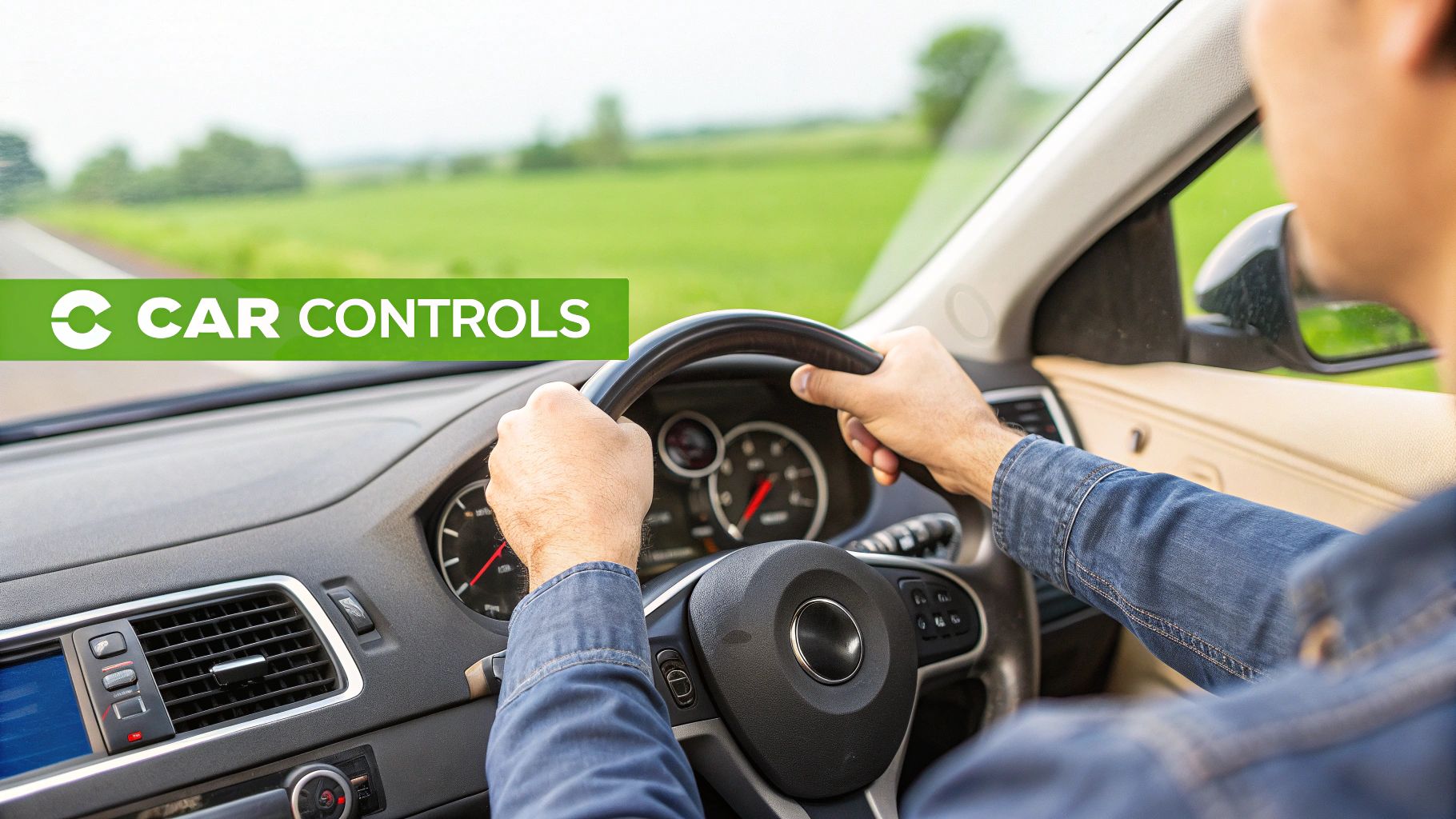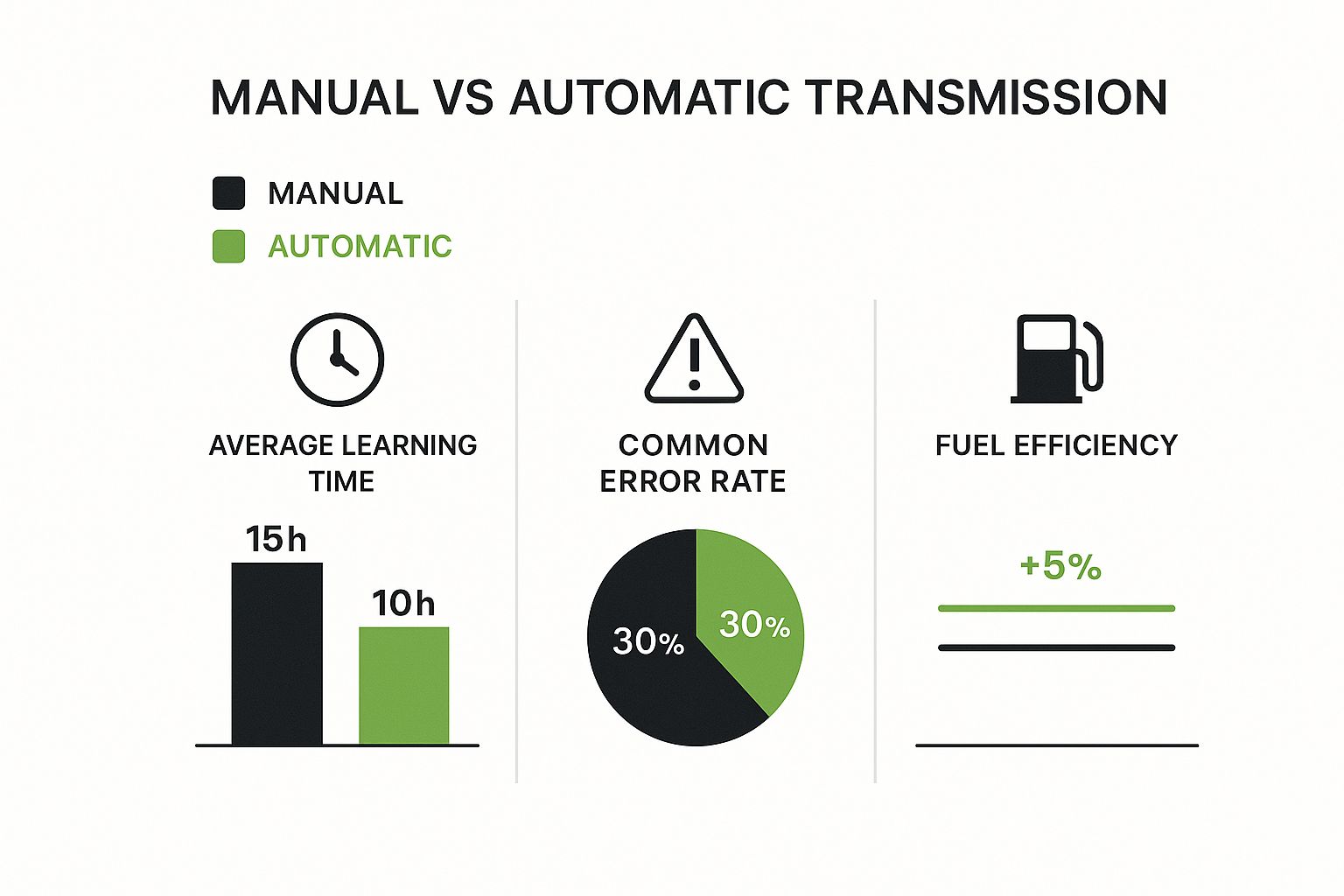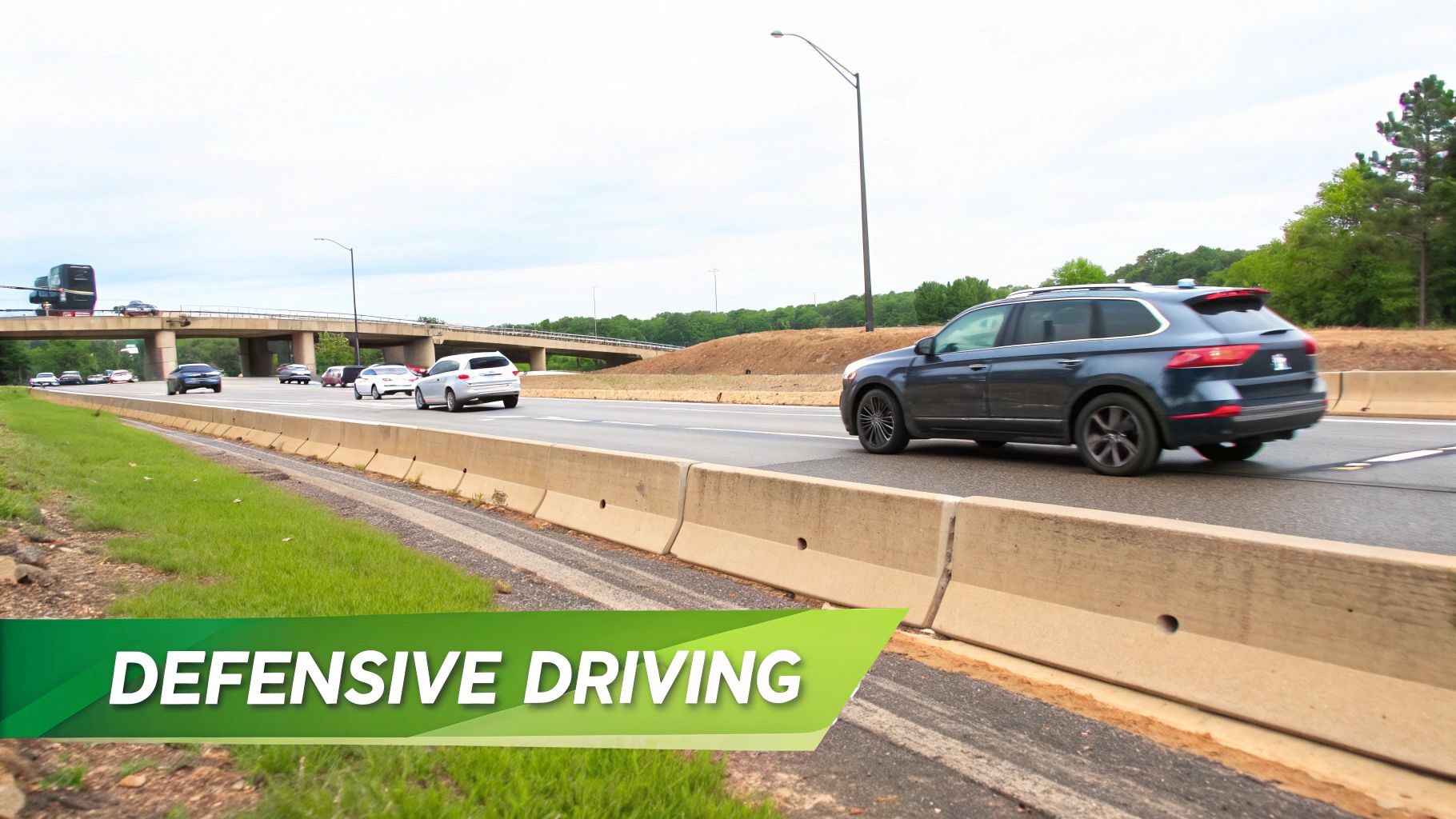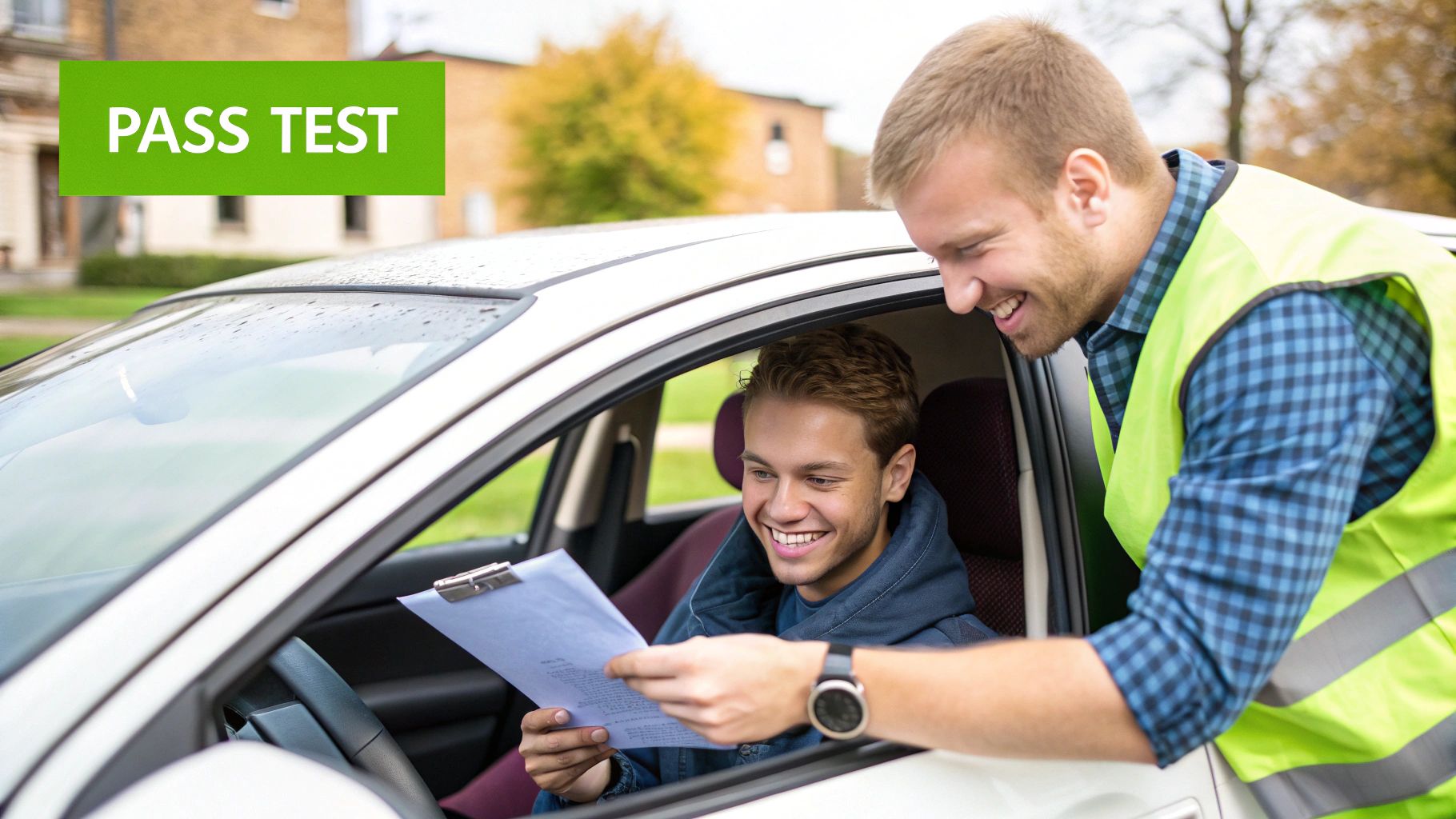Navigating the UK Driving Landscape With Confidence

Learning to drive in the UK involves more than just operating a vehicle. It's about understanding the specific environment, including road layouts, driving etiquette, and typical traffic patterns. This understanding of the UK driving landscape is the key to faster learning.
Familiarizing yourself with common UK road signs and markings early in your learning journey can significantly improve reaction time, boosting both safety and confidence. This foundation allows you to build skills more effectively.
Additionally, understanding the nuances of British road etiquette contributes to quicker learning. This includes unwritten rules such as yielding to pedestrians at zebra crossings and navigating roundabouts smoothly. These small details can significantly impact your learning curve. By mastering them early, you free up mental capacity for more advanced maneuvers.
However, common misconceptions can hinder learning. One such misconception is that more practice automatically equals faster learning. In reality, focused practice tailored to UK road conditions is far more effective than simply accumulating hours behind the wheel. Quality over quantity is the key.
Understanding the prevalence of driving licenses is also important. As of 2022, over 70% of UK residents over 17 held a driving license, with 81% of males and 71% of females holding licenses. Find more detailed statistics here. This highlights the importance of efficient learning strategies in a driving-centric culture like the UK.
Understanding the UK Driving Culture
Learning to drive quickly in the UK requires adapting to the unique driving culture. This means anticipating the actions of other drivers, navigating varied road types from motorways to narrow country lanes, and understanding regional driving styles. By embracing these challenges and opportunities, learners can significantly accelerate their progress.
Why UK Road Etiquette Matters
British road etiquette is fundamental to safe and confident driving. This encompasses everything from proper signaling and lane discipline to maintaining safe following distances and showing courtesy to other road users. Mastering these practices not only improves your driving skills but also creates a more positive and efficient learning experience. This positive reinforcement can further boost confidence and motivation, leading to faster progress.
Fast-Track Learning Methods That Actually Deliver Results

The infographic above highlights key differences between learning to drive with manual and automatic transmissions. It compares average learning time, common error rate, and fuel efficiency. Automatic transmission often leads to quicker learning with fewer errors, while manual offers a slight edge in fuel efficiency. Choosing the right transmission can significantly influence how quickly you learn.
So, what’s the fastest way to get your license? The structure of your learning journey plays a vital role. Intensive driving courses, often called "crash courses," condense the learning experience, allowing you to cover a lot of ground quickly. For more information, check out this helpful resource: How to master intensive courses. These courses are particularly effective for those who can dedicate a solid block of time to learning.
Intensive vs. Traditional Lessons
However, intensive courses aren’t the perfect solution for everyone. Some learners prefer the steady, spaced-out practice of traditional weekly lessons. This approach allows for gradual skill development and regular feedback from your driving instructor. Ultimately, the best learning structure depends on your individual learning style and available time.
The Psychology of Fast Learning
Beyond the practical aspects of lessons and practice, the psychological side of learning to drive is crucial. Managing anxiety and building confidence are essential for making quick progress. Visualization techniques, where you mentally rehearse driving scenarios, can be incredibly helpful for developing muscle memory and reducing nerves.
For example, imagine yourself smoothly navigating a roundabout or confidently parallel parking. This mental preparation can significantly improve your on-the-road performance. Open communication with your instructor is also vital for receiving constructive feedback and addressing areas for improvement.
To help you understand the key differences between these two learning methods, let's take a look at the following comparison:
Traditional vs. Intensive Driving Course Comparison
This table compares traditional weekly driving lessons with intensive crash courses across various factors including time to proficiency, cost implications, and success rates.
| Learning Factor | Traditional Weekly Lessons | Intensive Crash Course |
|---|---|---|
| Time Commitment | 1-2 hours per week, spread over several months | Typically 1-2 weeks of full-time learning |
| Cost | Generally lower overall cost, spread out over time | Higher upfront cost, but potentially faster results |
| Flexibility | More flexible scheduling options | Requires a significant block of dedicated time |
| Learning Style | Suitable for those who prefer gradual learning and consistent practice | Ideal for those who learn best through immersion and rapid progress |
| Success Rate | Dependent on individual commitment and learning style | Can be highly effective for motivated learners with focused time availability |
As you can see, both methods have their advantages and disadvantages. The best approach depends on your personal circumstances and preferences.
In the UK, the Driver and Vehicle Licensing Agency (DVLA) provides valuable data on driving trends. This data is crucial for improving driving skills and license acquisition rates. With digital driving licenses on the horizon for 2025, the UK aims to streamline the licensing process. When planning your learning journey, remember to factor in the cost of resources and lessons. This guide on SEO cost UK can give you an idea of potential investment costs, which can be applied to understanding driving lesson expenses as well.
Mastering Essential UK Driving Skills in Record Time

Mastering essential driving skills in the UK involves more than just the basics. It's about confidently handling the distinct challenges of British roads, from navigating roundabouts to parallel parking on narrow streets and confidently handling city traffic. The key to success often lies in breaking these skills down into smaller, more manageable steps. For instance, approaching a roundabout becomes less intimidating when you prioritize proper lane positioning and signal your intentions early.
Conquering Roundabouts and Other UK Challenges
Roundabouts are a common sight on UK roads. While they can be daunting for learners, the right approach can help you conquer them quickly. Understanding the rules of priority and clearly signaling your intentions are crucial. City driving also presents unique challenges, like navigating complex junctions and sharing the road with pedestrians and cyclists. Each of these elements contributes to overall driving proficiency in the UK.
This means anticipating the actions of other drivers and making safe, decisive maneuvers. Parallel parking, often a challenge for new drivers, becomes easier with consistent practice and a good understanding of spatial awareness. This involves accurately judging distances and executing precise steering. For more guidance on hazard perception, check out this helpful resource: How to master your hazard perception test.
Practice Sequences for Rapid Skill Development
Strategic practice is key to building confidence and competence quickly. Effective practice for skills like parallel parking involves starting in a controlled environment, such as a quiet car park, and gradually increasing the difficulty. This allows learners to focus on the mechanics of the maneuver before dealing with the added pressure of traffic.
Similarly, mastering roundabout navigation can be accelerated by starting with smaller, less busy roundabouts before tackling larger, multi-lane ones. Instructor insights highlight that focused practice in these key areas can significantly reduce learning times.
Furthermore, understanding the broader context of UK driving is essential. The UK's driving statistics underscore the importance of licensing and registration. Annual statistics from the GOV.UK website offer insights into licensed vehicles and new registrations. Find more detailed statistics here: https://www.gov.uk/government/statistics/announcements/vehicle-licensing-statistics-2025. This information provides learners with a better understanding of the traffic volume they'll encounter on UK roads.
The Power of Mental Rehearsal
Beyond physical practice, mental rehearsal plays a crucial role in rapid skill development. Visualizing successful maneuvers, such as smoothly entering a motorway or confidently overtaking, can strengthen neural pathways and enhance muscle memory. This technique allows learners to mentally practice challenging situations, building confidence and reducing anxiety when faced with real-world scenarios.
Combining mental rehearsal with physical practice creates a powerful synergistic effect, leading to accelerated learning and a quicker path to becoming a confident and competent driver in the UK. This approach not only builds skill but also fosters confidence, enabling learners to navigate UK roads with assurance.
Psychological Techniques That Transform Learning Speed
The speed at which you learn to drive isn't solely about coordination; your mindset plays a crucial role. Your mental approach significantly impacts how quickly you acquire driving skills on UK roads. This involves managing anxiety, building confidence, and staying focused. These elements create a solid base for rapid improvement and a more positive learning experience.
Managing Driving Anxiety and Building Confidence
Anxiety is a common obstacle for learner drivers. However, managing this nervous energy can actually fuel your learning. Controlled breathing exercises can help calm nerves before and during lessons. Visualization, a technique used by many successful learners, involves mentally rehearsing driving scenarios.
Imagine yourself confidently navigating a roundabout or smoothly parallel parking. This mental preparation builds confidence and reduces anxiety when you encounter these situations in real life. Maintaining a positive inner dialogue is also essential.
Replace self-doubt with affirmations and concentrate on your progress, however small. Celebrate every milestone, from mastering clutch control to navigating a busy junction.
To help illustrate some effective anxiety management techniques, let’s take a look at the following table. It outlines various psychological approaches that can enhance your learning speed and overall driving experience.
Driving Anxiety Management Techniques
This table presents effective techniques for managing driving anxiety and improving learning speed through psychological approaches.
| Technique | How It Works | When To Apply | Expected Benefits |
|---|---|---|---|
| Deep Breathing | Slows heart rate, calms nerves | Before and during lessons, stressful situations | Reduced anxiety, clearer thinking |
| Visualization | Mental rehearsal of driving scenarios | Before practicing maneuvers, challenging routes | Increased confidence, improved performance |
| Positive Self-Talk | Replacing negative thoughts with affirmations | When facing self-doubt, challenging situations | Improved confidence, reduced stress |
| Open Communication with Instructor | Addressing concerns, seeking feedback | During and after lessons, when facing difficulties | Targeted learning, faster progress |
As shown in the table above, combining techniques such as deep breathing with positive self-talk can significantly improve your focus and reduce stress while driving.
The Instructor-Learner Dynamic and Productive Communication
Your relationship with your driving instructor also plays a key role in your learning progress. Open communication is vital for quick improvement. Don't hesitate to ask questions, clarify doubts, and seek feedback. A good instructor offers personalized guidance and helps you pinpoint areas for improvement.
This collaborative approach makes lessons focused and productive. Constructive feedback, even when addressing weaknesses, is essential for growth. See your instructor as a mentor and actively participate in setting learning goals.
This partnership creates a supportive learning environment, accelerating skill development and boosting confidence on the road. Remember, learning to drive quickly involves getting the most out of each lesson through clear communication and a strong instructor-learner connection.
Practical Visualization Techniques for UK Driving Scenarios
Visualization is a powerful learning tool. Imagine yourself successfully handling challenging UK driving scenarios, such as merging onto a motorway during rush hour or navigating a complex roundabout. This mental rehearsal strengthens neural pathways, improving muscle memory and lessening anxiety.
This proactive approach can transform nervous energy into focused action, making a real difference in your driving performance. By using these psychological techniques, you can optimize your learning process and gain confidence behind the wheel faster. This mental preparation, along with practical lessons, can greatly improve your driving skills and help you achieve your driving goals more quickly.
Leveraging Technology To Accelerate Your Driving Journey
Today's smart learners are maximizing their driving education by integrating technology into every aspect of their learning journey. This includes utilizing digital tools, from apps and simulators to online resources that accurately reflect UK road conditions.
Digital Tools For UK Learners
Driving simulators offer a safe and controlled environment to practice challenging maneuvers, such as navigating roundabouts or perfecting parallel parking, without the pressures of real-world traffic. Many apps provide hazard perception practice and mock theory tests, helping learners prepare for the UK driving test. Using resources tailored to UK roads ensures relevant practice, familiarizing learners with the specific challenges of British driving and accelerating their overall progress.
Numerous apps are available to reinforce learning between lessons. These can cover various aspects of driving, from hazard perception to practicing for the theory test.
Video Analysis and Virtual Reality: The Future of Driving Instruction?
Video analysis provides valuable feedback for driving improvement. Recording your practice sessions and reviewing them with an instructor can highlight subtle areas for improvement, such as steering adjustments and observation skills. To delve deeper into how technology can be personalized for accelerated learning, consider exploring resources like Personalized Learning Paths. Similarly, virtual reality (VR) is emerging as a valuable tool in driver education. Immersive VR experiences can simulate complex traffic scenarios, preparing learners for real-world challenges in a risk-free environment. This exposure to diverse situations, beyond what's typically encountered during standard lessons, further accelerates the learning process.
VR technology provides a safe and immersive environment where you can experience a wide range of driving scenarios.
Choosing The Right Tech For Faster Learning
While many apps and tools offer engaging experiences, not all contribute effectively to faster learning. Prioritize resources that provide structured learning paths, personalized feedback, and alignment with the UK Highway Code. This focused approach will ensure efficient skill development and effective learning, rather than just entertainment. Selecting the right technology complements traditional instruction, leading to quicker mastery of essential driving skills.
Remember to choose apps and platforms aligned with the UK Highway Code for the most relevant and beneficial learning experience.
Integrating Technology With Hands-On Learning
The most effective approach combines the benefits of hands-on driving lessons with the strategic use of digital tools. Use apps and simulators between lessons to practice specific skills and reinforce what you've learned with your instructor. This blended learning approach maximizes efficiency, leading to faster progress and a shorter path to obtaining your UK driving license. Ultimately, technology serves to enhance, not replace, essential in-car instruction.
The key is to use technology strategically to enhance your learning, not to rely on it as a replacement for practical lessons with a qualified instructor.
From Learner To Licensed: Passing Your UK Test Rapidly

Passing both your theory and practical driving tests, ideally on the first try, is the ultimate goal for any aspiring driver. This section outlines how to achieve that goal quickly and efficiently, focusing on the key differences between first-time passes and those requiring multiple attempts.
Common Mistakes To Avoid During The UK Driving Test
Even the most confident learners can falter under the pressure of a driving test. Inadequate observation, particularly at roundabouts and junctions, is a common error. This can result in missed opportunities and potentially dangerous situations.
Another frequent mistake is incorrect speed management. This includes driving too slowly and impeding traffic, as well as exceeding the speed limit.
Approaching a roundabout too quickly, for example, can lead to poor lane positioning and heighten the risk of an incident. Hesitation and indecision can also negatively affect your test performance. Consistent practice until these skills become automatic will boost your confidence and minimize errors. You might be interested in: How to master your driving test.
Structuring Your Final Preparation Phase
The weeks leading up to your test should be focused and strategic. This involves more than simply increasing your practice hours. It requires targeted practice in areas where you feel less confident.
If navigating roundabouts presents a challenge, for example, spend extra time practicing this skill on different roundabout types. Mock tests are invaluable. They simulate the actual test conditions, allowing you to familiarize yourself with the format and manage test-day nerves.
Structured preparation tailored to the UK test format will significantly improve your chances of success. This targeted approach ensures thorough preparation without wasted practice time.
Theory Test Mastery And Memory Techniques
The theory test involves memorizing a considerable amount of information. Effective memory techniques can significantly boost your learning and retention. Mnemonics, such as rhymes or acronyms, can help you remember facts and rules.
You could create a rhyme to remember the sequence of actions at a traffic light, or an acronym for different road markings. Practicing with mock theory tests is crucial. This familiarizes you with the question styles and format, increasing confidence and preparing you for the actual test.
Consistent practice reinforces your knowledge and identifies areas needing further review. By combining these techniques, you can efficiently master the theory test material and improve your first-time pass rate.
Test-Day Management And Mindset Shifts
Managing your nerves and staying focused are essential for test-day success. Get a good night's sleep and arrive early to familiarize yourself with the test centre and its surroundings. This reduces anxiety and allows you to concentrate.
During the test, remember to breathe deeply and focus on the examiner's instructions. Visualize success and concentrate on showcasing your best driving.
A positive mindset can significantly impact your performance. Replace self-doubt with confidence and focus on your strengths. Maintaining a calm and positive attitude throughout the test can improve your driving and chances of a first-time pass.
Pre-Test Checklist And Timeline
A comprehensive pre-test checklist ensures you're fully prepared for both tests. This includes reviewing the Highway Code , practicing mock tests, and verifying your vehicle is in good working order.
A realistic timeline leading up to the test helps structure your learning effectively, preventing last-minute cramming and maximizing your success chances. By planning ahead and preparing methodically, you can approach your test with confidence and significantly increase your likelihood of quickly obtaining your driving licence.
Ready to fast-track your driving journey and pass your UK driving test with confidence? Fast Pass Driving Courses offers intensive and semi-intensive courses designed to get you on the road quickly. Visit us today to find the ideal course for your needs and accelerate your path to becoming a licensed driver!

